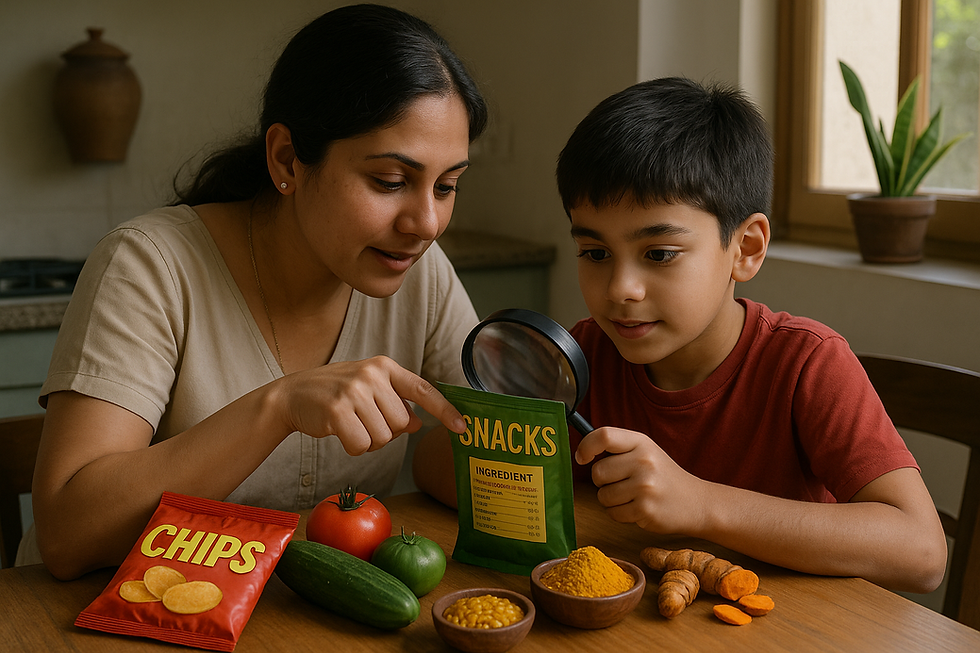Perfect Preschooler Portions: Indian Parents Visual Guide
- Dr Tejal Risbud Rao

- Jul 30
- 4 min read
Getting portions right for your 3-5 year old's healthy growth without the mealtime battles

As an Indian parent, you've probably heard this before: "Beta, just one more bite!" Whether it's coming from you, grandparents, or well-meaning relatives, the pressure to get our preschoolers to eat "enough" is real.
But here's the thing – determining what's actually "enough" for a 3-5 year old can feel like solving a puzzle. The good news? Understanding appropriate portion sizes for preschoolers isn't as complicated as it seems.
Why Preschooler Portions Matter
Children aged 1-3 years need approximately 1,060 calories per day, while those aged 4-6 years require about 1,350 calories daily. But remember! These are general guidelines. Every child's needs vary based on their activity level, growth rate, and individual metabolism.
The Four Golden Rules
Small stomachs, frequent meals - A preschooler's stomach is about the size of their fist
Quality over quantity - Focus on nutrient-dense foods rather than large portions
Child-led appetite - Go by your child's appetite cues
Consistent meal schedule - Offer 3 meals and 2-3 healthy snacks each day
The Game-Changing Visual Guide to Perfect Preschooler Portions
Instead of measuring cups and kitchen scales, use your child's own hands as portion guides. This system automatically adjusts as your child grows – it's brilliant in its simplicity!

Child's Palm = Protein Serving
1 small egg or 2 tablespoons paneer
2-3 pieces of chicken (child's palm size)
1/4 cup cooked dal or 2 tablespoons cooked rajma
Child's Fist = Carbohydrate Serving
1/2 small roti or 1/4 cup cooked rice
1 small slice of bread or 1/4 cup upma
2-3 small idlis or 1 small dosa
Child's Cupped Hand = Vegetable Serving
1/4 cup cooked vegetables (sabzi)
2-3 cherry tomatoes or 3-4 carrot sticks
1/2 cup mixed vegetable curry
Child's Thumb = Fat Serving
1 teaspoon ghee or oil for cooking
1/4 of a small avocado or 6-8 almonds
How to Apply This to Indian Meals
The Preschooler Indian Thali
Using the hand guides, a balanced Indian meal looks like:

Protein (palm): 1/4 cup dal or 2 tablespoons paneer
Carbs (fist): 1/2 small roti + 2-3 tablespoons rice
Vegetables (cupped hand): 1/4 cup sabzi
Fat (thumb): 1 teaspoon ghee
Extra: 1 tablespoon curd + small piece fruit
Sample Applications
Breakfast: 1-2 small idlis (fist) + 2 tablespoons sambar (palm) + 1/4 cup fruit
Lunch: 1/4 cup dal-chawal + 2 tablespoons vegetables + 1 tablespoon curd
Snack: 1/4 cup seasonal fruit or 2-3 small dhoklas
Dinner: Similar to lunch but lighter portions
What's Normal vs. Red Flags
As a parent, it's natural to worry about whether your preschooler is eating "enough." The truth is, children's eating patterns can be quite erratic, and what seems concerning might actually be completely normal behavior. Here's how to tell the difference between typical preschooler eating habits and signs that might need attention.
Completely Normal:
Appetite fluctuations from day to day
Growth spurts with increased appetite
Food preferences lasting for weeks
Taking 20-30 minutes to finish meals
When to Adjust:
Consistently leaving food (portions too large)
Always asking for more (may need larger portions)
Refusing meals regularly (portion overwhelm)
Excessive weight changes (consult pediatrician)
Solving Common Parent Concerns
"My child isn't eating enough vegetables!" Start with 1-2 tablespoons (smaller than cupped hand) and gradually increase. Mix vegetables into familiar foods like dal or rice.
"They only want rice/roti!" 1/4 cup rice or 1/2 small roti is sufficient for the carb portion. Balance with protein and vegetables using the hand guides.
"Grandparents say the child looks thin!" Focus on energy levels and growth charts rather than appearance. Show family members the hand-size guides so everyone understands appropriate portions.
Creating Positive Mealtimes
Eat together when possible - children learn by watching
Avoid distractions during meals
Ask "Are you still hungry?" to teach body awareness
Stay calm if they don't finish everything
Use the hand guides consistently - make it a fun game!
Quick Reference: Hand Guide Summary
Body Part | Food Type | Examples |
Palm | Protein | Dal, paneer, egg, chicken |
Fist | Carbs | Roti, rice, idli, dosa |
Cupped Hand | Vegetables | Sabzi, raw vegetables |
Thumb | Fats | Ghee, oil, nuts |
Need Personalized Meal Plans?
While these portion guides work for any Indian meal, every family has unique preferences, dietary needs, and challenges.
Want customized meal plans that work specifically for your child and family routine?
Email us at happykidspeds@gmail.com for personalized weekly meal plans
DM us at Instagram (https://www.instagram.com/happykids_pediatrics/) for quick questions about your child's specific needs
Get custom plans that include your family's favorite foods and accommodate any dietary restrictions
We create detailed, practical meal plans that take the guesswork out of feeding your preschooler while respecting your cultural food preferences and family schedule.
Remember: Every Child is Different
These hand-size portion guides are your starting point – they're not rigid rules. Trust your child's appetite cues, focus on offering variety and nutrition, and remember that establishing healthy eating habits is more important than finishing every bite.
The beauty of the hand guide system is its simplicity. No measuring cups, no complicated calculations – just your child's own hand as the perfect portion guide that grows with them.
Most importantly, feeding challenges are temporary. With patience, consistency, and these age-appropriate portion guides, your preschooler will develop a healthy relationship with food that will serve them well throughout their life.
References
American Academy of Pediatrics. (2019). Caring for Your Baby and Young Child: Birth to Age 5. 7th Edition. Bantam Books.
American Academy of Pediatrics. (2025). "Feeding the Young Child." Pediatric Nutrition, 9th Edition.
World Health Organization. (2020). "Healthy Diet." Fact Sheet No. 394. WHO Press.
National Institute of Nutrition, Hyderabad. (2024). "Dietary Guidelines for Indians - A Manual." ICMR-NIN, Government of India.
Ministry of Women and Child Development, Government of India. "Nutrition Resource Platform." Child Development and Nutrition Bureau.





Comments